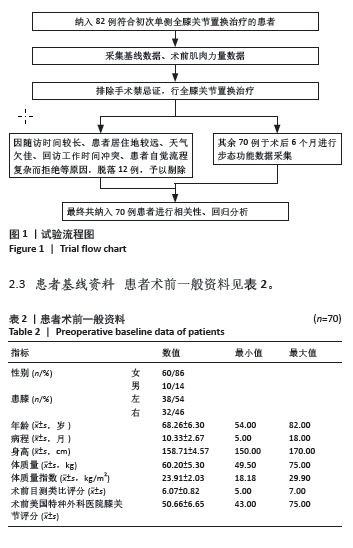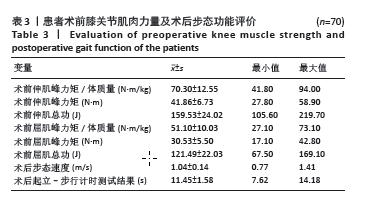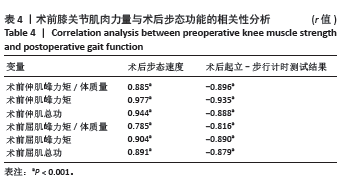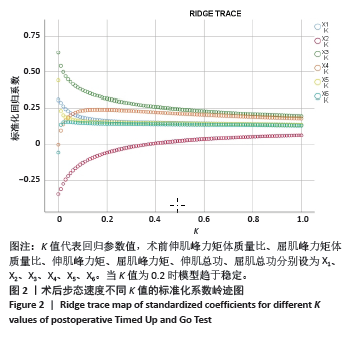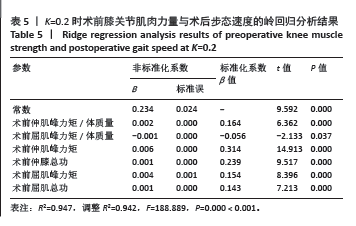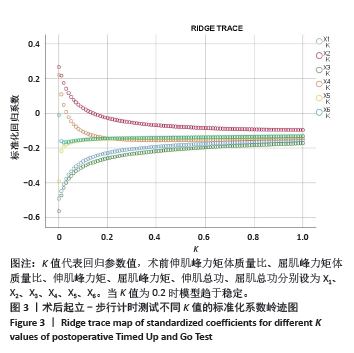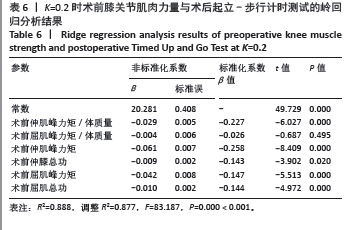[1] ZHU Z, TANG T, PAN S, et al. Effect of knee joint weight change on knee function recovery and gait after total knee arthroplasty. BMC Musculoskelet Disord. 2022;23(1):694.
[2] HEIJBEL S, NAILI JE, HEDIN A, et al. The Forgotten Joint Score-12 in Swedish patients undergoing knee arthroplasty: a validation study with the Knee Injury and Osteoarthritis Outcome Score (KOOS) as comparator. Acta Orthop. 2020;91(1):88-93.
[3] CONDE J, SCOTECE M, GOMEZ R, et al. Adipokines and osteoarthritis: novel molecules involved in the pathogenesis and progression of disease. Arthritis. 2011;2011:203901.
[4] 谢泰安. 关节置换术治疗老年膝关节退行性骨关节炎的临床疗效探讨[J]. 中国全科医学,2021,24(S2):135-137.
[5] INACIO M, PAXTON EW, GRAVES SE, et al. Projected increase in total knee arthroplasty in the United States - an alternative projection model. Osteoarthritis Cartilage. 2017;25(11):1797-1803.
[6] BURGER JA, DOOLEY MS, KLEEBLAD LJ, et al. What is the impact of patellofemoral joint degeneration and malalignment on patient-reported outcomes after lateral unicompartmental knee arthroplasty? Bone Joint J. 2020;102-B(6):727-735.
[7] MAXWELL J, NIU J, SINGH JA, et al. The influence of the contralateral knee prior to knee arthroplasty on post-arthroplasty function: the multicenter osteoarthritis study. J Bone Joint Surg Am. 2013;95(11): 989-993.
[8] 杨鑫煜, 王伟韬, 赵波, 等. 初次膝关节置换术后一年步态分析参数与患者满意度的研究[J]. 中国骨与关节杂志,2021,10(7):497-501.
[9] BADE MJ, KOHRT WM, STEVENS-LAPSLEY JE. Outcomes before and after total knee arthroplasty compared to healthy adults. J Orthop Sports Phys Ther. 2010;40(9):559-567.
[10] YASUDA T, HONDA S, MATSUNAGA K, et al. Association of preoperative muscle composition of the lower extremity with gait function after total knee arthroplasty. J Orthop Sci. 2023;28(1):188-194.
[11] ZENG Z, SHAN J, ZHANG Y, et al. Asymmetries and relationships between muscle strength, proprioception, biomechanics, and postural stability in patients with unilateral knee osteoarthritis. Front Bioeng Biotechnol. 2022;10:922832.
[12] MOHAJER B, DOLATSHAHI M, MORADI K, et al. Role of Thigh Muscle Changes in Knee Osteoarthritis Outcomes: Osteoarthritis Initiative Data. Radiology. 2022;305(1):169-178.
[13] FRONTERA WR, HUGHES VA, LUTZ KJ, et al. A cross-sectional study of muscle strength and mass in 45- to 78-yr-old men and women. J Appl Physiol (1985). 1991;71(2):644-650.
[14] 陈国茜, 陈泽华, 叶翔凌, 等. 基于肌肉功能和质量探讨肌肉与膝骨关节炎关系的研究进展[J]. 中华物理医学与康复杂志,2022, 44(5):471-475.
[15] Young-Shand KL, Dunbar MJ, Astephen WJ. Individual Gait Features Are Associated with Clinical Improvement After Total Knee Arthroplasty. JB JS Open Access. 2020;5(2):e38.
[16] 杜东, 尹瑞雪, 何任红, 等. 等速肌力测试在躯干核心肌群中的应用进展[J]. 中国康复理论与实践,2019,25(3):338-340.
[17] GUILHEM G, GIROUX C, COUTURIER A, et al. Validity of trunk extensor and flexor torque measurements using isokinetic dynamometry. J Electromyogr Kinesiol. 2014;24(6):986-993.
[18] 郑尉, 孙立冰, 熊莹喆, 等. 离心训练对腘绳肌肌力影响的Meta分析[J]. 中国组织工程研究,2022,26(29):4749-4756.
[19] 陈志豪, 李乾, 胡刚峰, 等. 等速肌力运动在关节置换中的应用[J]. 中华关节外科杂志(电子版),2021,15(2):219-224.
[20] JONES CA, COX V, JHANGRI GS, et al. Delineating the impact of obesity and its relationship on recovery after total joint arthroplasties. Osteoarthritis Cartilage. 2012;20(6):511-518.
[21] DOBSON F, HINMAN RS, HALL M, et al. Reliability and measurement error of the Osteoarthritis Research Society International (OARSI) recommended performance-based tests of physical function in people with hip and knee osteoarthritis. Osteoarthritis Cartilage. 2017;25(11): 1792-1796.
[22] AMATACHAYA S, KWANMONGKOLTHONG M, THONGJUMROON A, et al. Influence of timing protocols and distance covered on the outcomes of the 10-meter walk test. Physiother Theory Pract. 2020;36(12):1348-1353.
[23] CHOI JH, KIM BR, KIM SR, et al. Performance-based physical function correlates with walking speed and distance at 3 months post unilateral total knee arthroplasty. Gait Posture. 2021;87:163-169.
[24] PODSIADLO D, RICHARDSON S. The timed “Up & Go”: a test of basic functional mobility for frail elderly persons. J Am Geriatr Soc. 1991; 39(2):142-148.
[25] 易德坤, 何永琴, 刘鑫, 等. 重庆城市老年人计时“起立-行走”测试跌倒临界值及其危险因素分析[J]. 陆军军医大学学报,2022, 44(16):1672-1676.
[26] DEYLE GD, ALLEN CS, ALLISON SC, et al. Physical Therapy versus Glucocorticoid Injection for Osteoarthritis of the Knee. N Engl J Med. 2020;382(15):1420-1429.
[27] 李维萍, 黄强, 豆敏. 全膝关节置换术后康复治疗的研究进展[J]. 中国医药,2020,15(3):473-476.
[28] GUNARATNE R, PRATT DN, BANDA J, et al. Patient Dissatisfaction Following Total Knee Arthroplasty: A Systematic Review of the Literature. J Arthroplasty. 2017;32(12):3854-3860.
[29] CANOVAS F, DAGNEAUX L. Quality of life after total knee arthroplasty. Orthop Traumatol Surg Res. 2018;104(1S):S41-S46.
[30] GOODPASTER BH, PARK SW, HARRIS TB, et al. The loss of skeletal muscle strength, mass, and quality in older adults: the health, aging and body composition study. J Gerontol A Biol Sci Med Sci. 2006;61(10):1059-1064.
[31] 李萍, 张振龙, 姬艳博, 等. 术前抗阻训练对全膝关节置换患者术后康复影响的Meta分析[J]. 中华现代护理杂志,2023,29(34):4670-4676.
[32] DEVASENAPATHY N, MADDISON R, MALHOTRA R, et al. Preoperative Quadriceps Muscle Strength and Functional Ability Predict Performance-Based Outcomes 6 Months After Total Knee Arthroplasty: A Systematic Review. Phys Ther. 2019;99(1):46-61.
[33] RO DH, HAN HS, LEE DY, et al. Slow gait speed after bilateral total knee arthroplasty is associated with suboptimal improvement of knee biomechanics. Knee Surg Sports Traumatol Arthrosc. 2018;26(6):1671-1680.
[34] IWATA A, SANO Y, WANAKA H, et al. Maximum knee extension velocity without external load is a stronger determinant of gait function than quadriceps strength in the early postoperative period following total knee arthroplasty. PLoS One. 2022;17(11):e276219.
[35] 刘晓林, 林坚, 黄雄昂, 等. 下肢肌肉链训练与股四头肌训练治疗膝骨关节炎的疗效对比研究[J]. 中国全科医学,2013,16(23):2143-2145.
[36] 程俊华, 程宇核, 陈霞平, 等. 肌筋膜链针刺联合富血小板血浆治疗膝骨性关节炎的临床研究[J]. 湖北医药学院学报,2023,42(3):268-272.
[37] 武永利, 李龙, 刘君伟, 等. 温针灸抑制NLRP3炎症小体激活改善兔膝骨关节炎的软骨损伤[J]. 中国组织工程研究,2023,27(20): 3202-3208.
[38] 李彦, 王向红, 刘兴兴, 等. 中药溻渍方对全膝关节置换术后功能恢复的影响[J]. 中国医药导报,2022,19(16):139-142.
[39] 张家媛, 姜涛, 林晓东, 等. 基于“脾病而四肢不用”理论从脾论治早期膝骨关节炎的理论探讨[J]. 中医正骨,2022,34(7):63-65. |
